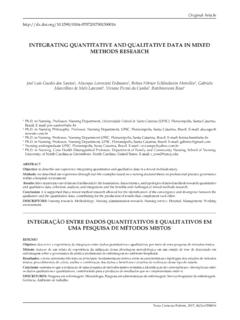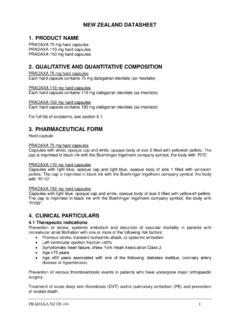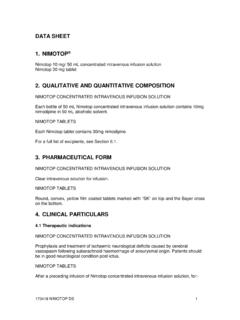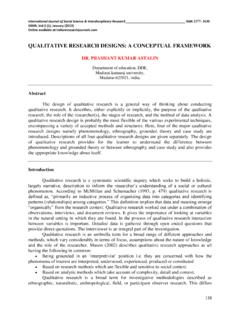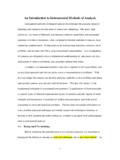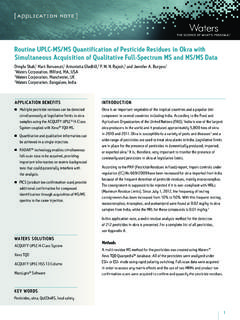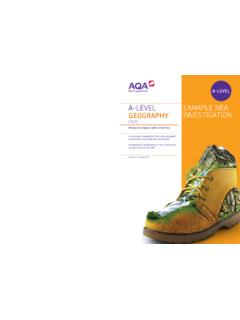Transcription of Educational Effectiveness Research (EER) - ICSEI
1 Educational Effectiveness Research (EER): A State of the Art Review David Reynolds, University of Southampton, UK Pam Sammons, University of Oxford, UK Bieke De Fraine, Catholic Univerisity of Leuven, Belgium Tony Townsend, University of Glasgow, UK Jan Van Damme, Catholic Univerisity of Leuven, Belgium Paper presented to the annual meeting of the International Congress for School Effectiveness and Improvement, Cyprus, 2011 Any comments, suggestions about material that may have been omitted and views about the conclusions of this review are very welcome, and should be sent to or Introduction Educational Effectiveness Research (EER) has shown rapid growth in the quantity and quality of the Research answers it can produce to its core, foundational questions, which can be simply summarised as: What makes a good school?
2 How do we make more schools good ? It looks at all the factors within schools in particular, and the Educational system in general, that might affect the learning outcomes of students in their academic and social development, which means it encompasses a wide range of factors such as teaching methods, the organisation - formally and informally - of schools, the curriculum and the effects of Educational learning environments in general. To undertake this complex task, EER involves sorting out the effects of schools from other effects such as those of prior attainment and Educational background, which therefore requires modelling tools that involve comparable complexity (Goldstein, 1995). Thus, the methodological issues of how we analyse complex data from multiple levels of the Educational system have had, and continue to have, a salience in EER more than in many other Educational specialities.
3 In this review we consider briefly after this introduction: The history or phases of EER; Theoretical and methodological advances in EER; The scientific properties of EER on the size of school effects, differential effects, their consistency, their stability over time, and the different outcomes of education; The processes of Educational Effectiveness ; The historical links between EER, and policy and practice; The future Research needs and possible policy and practice links of EER; The future directions for EER, in a changing international society. We should note that we are using the term Educational Effectiveness Research rather than School Effectiveness Research here as a reflection of the wide range of topics that the field has now encompassed in its forty year existence, and of the breadth which it now covers (Muijs, 2006; Creemers, Kyriakides & Sammons, 2010).
4 The History of EER There are a large number of publications which review the field s history (Gray et al, 1996; Mortimore, 1991; Sammons, 1999; Townsend, 2007; Reynolds, 2010b; Teddlie, 2010; Creemers, Kyriakides & Sammons, 2010; Reynolds et al, 1994; Teddlie & Reynolds, 2000), so we will only briefly summarise the phases that EER has gone through here. There are probably five. The first phase emerged as a reaction to the seminal studies of Coleman et al, (1966) and Jencks et al, (1972), who concluded that schools had little effect upon the outcomes of their students by comparison to the effects of their own ability and social backgrounds. The belief was commonplace that schools make no difference and that education cannot compensate for society (Bernstein, 1968). Into this climate came the empirical studies of Edmonds, (1979), Rutter et al, (1979), Smith & Tomlinson, (1989), Mortimore et al, (1988) and the smaller, one off case studies of researchers such as Weber, (1971) and Reynolds, (1976).
5 The second phase ran from the mid 1980s, in which the use of multilevel methodologies (Goldstein, 1995) and methodologically sophisticated studies began to show the scientific properties of school effects in such areas as the stability of school effects over time, the consistency of school effects upon different outcome domains, the differential effects of school upon students of different background characteristics, the size of school effects and the long term effects of schools (see reviews in the Special Country Reports Issue of School Effectiveness and School Improvement, Vol. 7 (2), 1996). Beginning probably in the early to mid 1990s was EER s third phase, in which there were numerous attempts to explore the reasons why schools had their different effects. Influential work here was the Louisiana School Effectiveness Studies of Teddlie and Stringfield (1993) in the United States, and work in the United Kingdom into subject Department effects upon performance and also upon school effects (Sammons et al, 1997).
6 These years also saw a number of influential reviews of the field such as by Scheerens & Bosker, (1997) and Reynolds et al, (1996). The fourth phase, which began in the mid to late 1990s, ran for a decade and is still in evidence today, is the marked internationalisation of the field, together with the merger or synergy of approaches generated by having, for example, school Effectiveness researchers in close intellectual proximity to school improvement researchers and practitioners. The international opportunities for networking, for joint Research in multiple countries and the powerful effects of different Research and country traditions in EER being opened up for learning from, for view, and for choice, meant that the field developed rapidly. Also, after calls for a merger of SE and SI concerns ( Reynolds, Hopkins, & Stoll, 1993) many SE researchers became more comfortable with SI s qualitative methodology, its commitment to more cultural views of school processes instead of to the formal organisational factors that had been the SE commitment, and its commitment to the importance of seeing teachers as something other than mere empirical/rational Educational actors.
7 The fifth phase has begun only recently in the late 2000s and is still developing rapidly, focussing on EER as a dynamic, not static, set of relationships and moving away from seeing education in particular as an inherently stable set of arrangements towards one that sees the various levels of the Educational system interacting and achieving variable outcomes (Creemers & Kyriakides, 2008). Additionally, and linked with this more dynamic perspective, is a commitment to newer forms of statistical analyses that can permit the establishment of indirect as well as direct relationships between Educational factors and student outcomes, and which can permit reciprocal relationships between Educational factors to be established, both permitted by the increased popularity of Structural Equation Modelling (SEM). We consider these issues in more detail below.
8 However, we should note that the early phases of EER may have laid down certain foundations that may have critically affected the intellectual and practical growth of EER. Of course, EER generated an international organisation ( ICSEI ), a journal located in the ISI Current Contents databases within six years of its launch and a volume of Research books and papers that justified over 1,500 references in the Teddlie & Reynolds (2000) International Handbook of School Effectiveness Research , and probably double that in the replacement volume currently being written and planned for 2012 publication. All these factors suggest considerable scientific success. However, much of the content of the paradigm of the discipline was in retrospect reactive, not purposive, and may have had negative consequences. Firstly, the commitment to quantitative methods within EER was of course easy to understand, given the need to demonstrate beyond doubt that schools varied in their effects, and given that few education researchers anywhere believed this in the 1980s.
9 The methodological apparatus that was necessary to sort out the varying influences of intakes of students upon outcomes, the need for large sample sizes, the need for individual data on each student at intake and outcome and the increasingly recognised need for multiple measures of Educational outcomes that reflected the multiple nature and goals of schooling, all necessitated sophisticated quantitative methods and approaches. However, the absence of much qualitative data that would have exemplified what the quantitative data were showing, and the absence of many mixed methods studies where quantitative data could demonstrate relationships between Educational factors and qualitative data could explain the relationships made the field and its findings difficult to access, for policymakers and practitioners particularly. Put simply, EER lacked rich, thick descriptions.
10 Even where factors were used which had often been the concern of qualitative Educational researchers historically teacher attitudes, school ethos, learning environment, school culture and students views for example and which had been the subject of their rich, thick descriptions , many EER studies substituted questionnaires, formal interviews and standardised systems of measurement, very few of which even had the qualitative data as examples of what the quantitative instruments were measuring, although there were some early mixed methods approaches ( Teddlie & Stringfield, 1993; Sammons, Thomas & Mortimore, 1997). Secondly, because EER grew up in a climate where it was believed schools make no difference , our assertion that schools did make a difference meant that EER locked itself into an almost exclusive concern with the school, rather than with the District/Local Authority and particularly rather than with the classroom and with the teacher.


